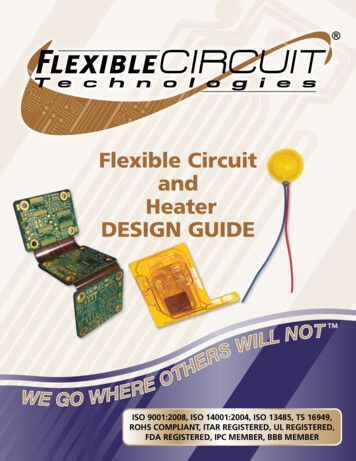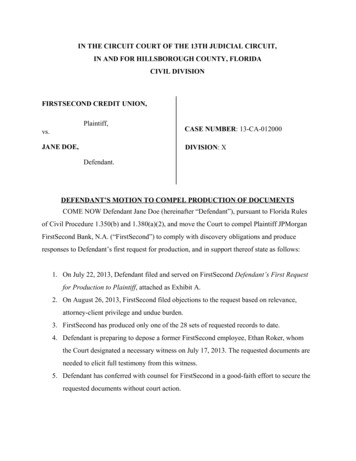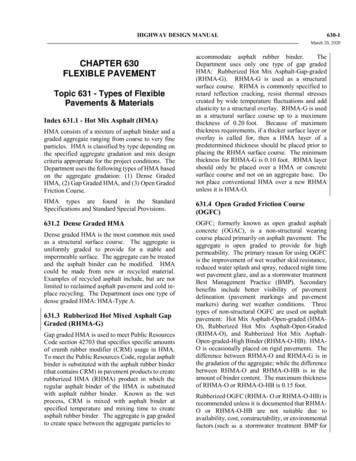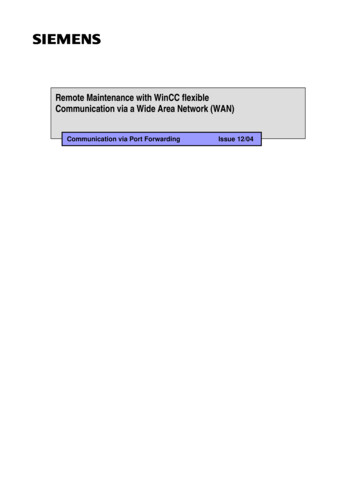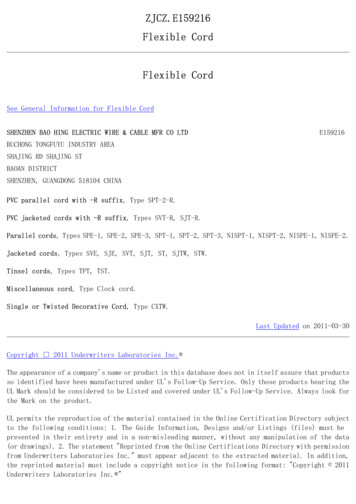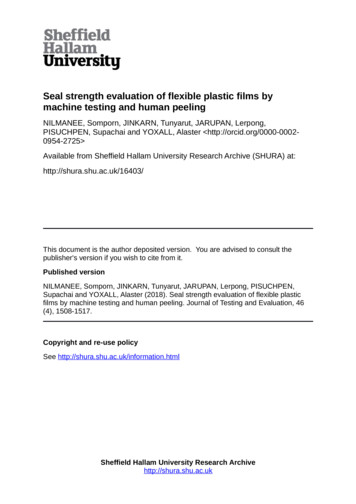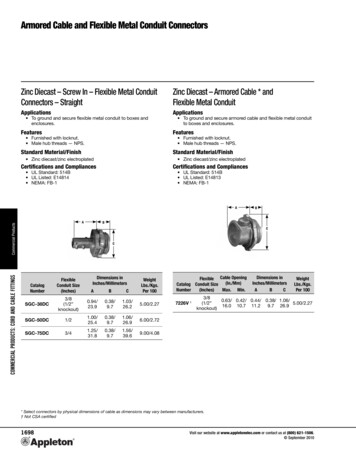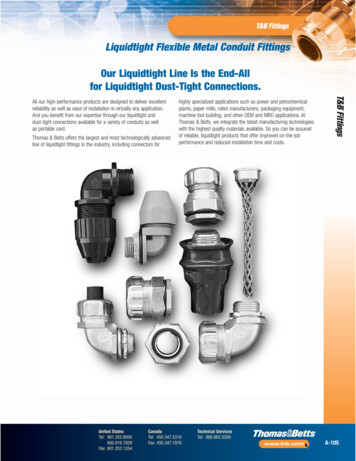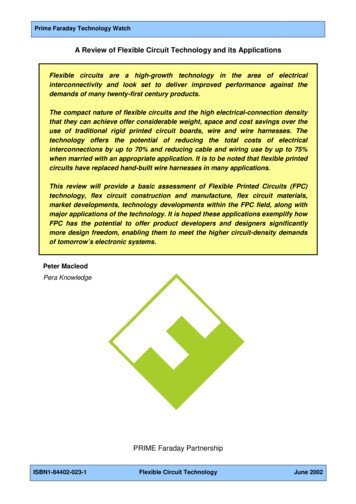
Transcription
Prime Faraday Technology WatchA Review of Flexible Circuit Technology and its ApplicationsFlexible circuits are a high-growth technology in the area of electricalinterconnectivity and look set to deliver improved performance against thedemands of many twenty-first century products.The compact nature of flexible circuits and the high electrical-connection densitythat they can achieve offer considerable weight, space and cost savings over theuse of traditional rigid printed circuit boards, wire and wire harnesses. Thetechnology offers the potential of reducing the total costs of electricalinterconnections by up to 70% and reducing cable and wiring use by up to 75%when married with an appropriate application. It is to be noted that flexible printedcircuits have replaced hand-built wire harnesses in many applications.This review will provide a basic assessment of Flexible Printed Circuits (FPC)technology, flex circuit construction and manufacture, flex circuit materials,market developments, technology developments within the FPC field, along withmajor applications of the technology. It is hoped these applications exemplify howFPC has the potential to offer product developers and designers significantlymore design freedom, enabling them to meet the higher circuit-density demandsof tomorrow’s electronic systems.Peter MacleodPera KnowledgePRIME Faraday PartnershipISBN1-84402-023-1Flexible Circuit TechnologyJune 2002
This title is for sale in paperback at IN/1844020231Technology Watch titles are written for managers, especially in smalland medium-sized manufacturing companies. They offer a practicalintroduction to cutting-edge developments that affect – or likely soonwill affect – the design, development, manufacture and marketing ofPRIME products – products with interdependent mechanical andelectronic (and possibly software) parts.All Technology Watch titles can be downloaded free of charge fromthe Prime Faraday Partnership’s Technology Watch websitehttp://www.primetechnologywatch.org.uk/. Selected titles can bepurchased in paperback from Amazon.co.uk.In addition to market and technology reviews, the Technology Watchwebsite also provides news cuttings, case studies, an events diary anddetails of funding opportunities. The service is sponsored by the DTIand managed by the PRIME Faraday Partnership, which marries theacademic strengths of Loughborough University and the University ofNottingham to the technology-transfer expertise of Pera.
A Review of Flexible Circuit Technology and its ApplicationsPublished in 2002 byPRIME Faraday PartnershipWolfson School of Mechanical and Manufacturing EngineeringLoughborough University, Loughborough, Leics LE11 3TUhttp://www.primetechnologywatch.org.uk 2002 Pera KnowledgeISBN 1-84402-023-1Whilst the advice and information in this publication is believed to betrue and accurate at the time of publication, neither the author nor thepublisher assume any legal responsibility or liability for any error oromission that may have been made.Comments on this publication are welcomed. Please send them to feedback@primetechnologywatch.org.uk Prime Faraday Technology Watch – June 2002
A Review of Flexible Circuit Technology and its ircuit Technology .22.1A Definition for Flexible Circuits .22.2Flexible-Circuit Constituents.32.3Materials Diversity Overview .32.4Flexible-Circuit Construction .52.4.1Single-Sided Flexible Circuits.52.4.2Double Access Flexible Circuits .62.4.3Double-Sided Flex Circuits.62.4.4Sculptured Flex .72.4.5Multilayer Flex Circuits .72.4.6Rigid-Flex Circuits.73.0Flexible-Circuit Materials .93.1Material Configuration .93.2Base Materials .103.2.1Polyimide .113.2.2Polyester.123.3Conductor Materials .133.3.1Copper.133.3.2Other Metal Foils.153.3.3Polymer Thick-Film Processes.163.3.4Emerging Direct Apply Technologies .173.4Adhesives .183.4.1Polyimide Adhesives .193.4.2Polyester Adhesive .203.4.3Acrylic Adhesive.203.4.4Epoxies and Modified Epoxies .203.4.5Other Adhesives .213.5Adhesiveless Laminates .213.6Protective Coatings.233.6.1Cover Lays (Cover layers) .233.6.2Cover Coatings (Cover Coats) .234.0Flex circuit Market and Applications.254.1Market.254.2The Benefits Of Flex .264.3Applications .274.3.1Automotive.284.3.2Telecommunications .314.3.3Aviation .325.0Manufacturing and Design of Flexible Circuits .345.1Manufacturing Flexible Circuits .345.2The Manufacturing Route.35PRIME Faraday Technology Watch – June 2002iii
A Review of Flexible Circuit Technology and its Applications5.2.1Clean the Laminate.355.2.2Image Resist.365.2.3Etch the Exposed Conductor.365.2.4Resist Removal.365.2.5Cover-Lay or Cover-Coat Placement .375.2.6Produce Holes and Outline .375.2.7Test and Verification .376.0Flexible-Circuit Design.396.1Basic Design Rules.396.2Implementation Recommendations .406.3Costing Flexible Circuits.427.0Flexible-Circuit Technology and Process Trends .447.1Adhesiveless Laminates .447.2Direct Apply Technologies .457.3New Substrate Materials .467.4Cover Coats: The Non-Cover-Lay Process .467.5The Next Generation of Applications – Chip Scale Packaging .478.0Sources of Assistance .498.1IPC - Association Connecting Electronics Industries .498.2PCIF .498.3European Institute of Printed Circuits (EIPC) .508.4Molded Interconnect Device Association.508.5Reference Publications .519.0Conclusions.52A.0 General References .53PRIME Faraday Technology Watch – June 2002iv
A Review of Flexible Circuit Technology and its Applications1.0 IntroductionFlexible printed circuits are found in everything from automobiles, VCR's, camcorders,portable phones and SLR cameras to sophisticated military and avionics systems.High-profile applications of flexible circuits are many. one example is the application offlexible-circuit technology in a rigid flex wire harness used on Sojourner, the robot thatroamed the surface of Mars collecting data during the summer of 1997.On a somewhat less romantic level, something as common as a notebook computer orflip-lid mobile phone would not be possible without flexible printed circuit technologywhich allows components to be electronically connected in a dynamic, threedimensional, way.Flexible-circuit technology has a well-established history that goes back nearly onehundred years. Early patent activity highlights the fact that concepts for flexible-circuitmaterials and designs, which have only come into commercial use within the last fewdecades, were speculated upon by inventors such as Thomas Edison, Frank Spragueand others in the early twentieth century.The heart and soul of Flexible Printed Circuits (FPCs) are the flexible films and thinlayers of conductive circuit traces. These typically constitute the base flexible-circuitlaminate, which can be utilised to interconnect electronic devices – such as the LCDscreen and keyboard of a laptop – as a reliable wiring replacement, or can haveelectronic components directly attached to it via soldering or conductive adhesive, toform a finished, pliable circuit board.Any assessment of the technology of flexible circuits quickly identifies a whole range ofbenefits that complement and surpass the capabilities of rigid printed circuit boards(PCBs). For many, the technology of flexible circuits and their wide applications may benew, and the view of flexible circuits may be restricted to that of simple point-to-pointconnections, as a replacement for traditional electrical wire for example. This iscurrently far from the case and the promise of flexible circuitry is highly significant. Withnew applications and new materials continually being designed and developed, thetechnology promises to revolutionise many aspects of electronic circuit design.This report introduces the subject of flexible circuits and highlights their advantagesand applications beyond the currently rigid, planar circuit-board technology. The reportalso highlights areas of opportunity for the application of flexible circuits, and in doingso conveys the potential for the technology to deliver new product developmentfreedoms and capabilities that may be used to develop both product and competitiveadvantage.PRIME Faraday Technology Watch – June 20021
A Review of Flexible Circuit Technology and its Applications2.0 Flexible-Circuit TechnologyThe advance of electronic systems into our everyday lives is evidence of a major digitaltechnology revolution. The success stories of the personal computer and the mobilephone serve to demonstrate that consumer and business demand for innovativeproducts are significant. Increasingly electrical and electronic systems are entering ourlives in many unanticipated ways. They can be found in our homes in the form ofcordless phones and digital TVs, in our cars in the form of hands-free communicationsand telematics, and in business in the form of notebook computers and mobilepersonal data assistants (PDAs).Importantly, and also covertly, within the above applications flexible printed circuitshave also been entering our lives. Traditionally employed in the role of wirereplacement, removing the need for complex wire harnesses, and replacing costly andincreasingly complicated wired assemblies, flexible circuits offer a much simpler andoften significantly more cost-effective interconnection method.However, alongside increasingly innovative applications flexible-circuit technology isbranching out significantly from this initial role and it is poised to be a technology thatwill provide enormous design freedoms for electronic engineers and product designersover the coming years. As the demands of modern electronic systems call forincreasing functionality, greater circuit density, higher connectivity, betterenvironmental performance, and all at lower cost, flexible circuitry is poised to deliveron the promise of twenty-first century electronics.2.1A Definition for Flexible CircuitsConfusion still exists regarding what constitutes a flexible circuit. When asked toenvisage a flexible circuit, the image in most people’s mind will be of a bendy printedcircuit, typically consisting of a flexible film with a pattern of copper conductors on it.Whilst the image is not far from the truth, in order to better understand flexible circuits itis important at the outset to establish a working definition. The IPC (formerly theInstitute for Interconnecting and Packaging Electronic Circuits), through its role ofsetting standards and guidelines for the electronics industry, has established such adefinition:Flexible Printed CircuitA patterned arrangement of printed circuitry and components that utilizes1flexible base material with or without flexible cover lay.1IPC (1996) IPC-T-50: Terms and Definitions for Interconnecting and Packaging Electronic Circuits, Revision F (June1996), IPC, Northbrook, ILPRIME Faraday Technology Watch – June 20022
A Review of Flexible Circuit Technology and its ApplicationsThe above definition, although strictly accurate, does little justice to the complexity ofthe technology but does serve to convey some of the potential given the availablevariations in base materials, conductor materials, and protective finishes.2.2Flexible-Circuit ConstituentsFrom the above definition, there are a number of basic material elements thatconstitute a flexible circuit: a dielectric substrate film (base material), electricalconductors (circuit traces), a protective finish (cover lay or cover coat), and, not least,adhesives to bond the various materials together. Together the above materials form abasic flexible-circuit laminate suitable for use as a simple wiring assembly, or capableafter further processing of forming a compliant final circuit assembly.Within a typical flexible-circuit construction the dielectric film forms the base layer, withadhesives used to bond the conductors to the dielectric and, in multilayer flexiblecircuits, to bond the individual layers together. Adhesives can also be used in aprotective capacity to cover the final circuit to prevent the ingress of moisture and dirt,when they are termed ‘cover lays’ (also ‘cover layers’) or ‘cover coats’.2.3Materials Diversity OverviewMany individual materials exist that time and extensive prototyping have provensuitable for application in flexible circuits. There are numerous substrate materials(termed dielectrics) available as very thin films of 12–120 microns in thickness thathave been prototyped as base materials upon which to build flexible circuits. However,the two most common dielectric substrate materials are polyester and polyimide. Bothare widely available from a number of global sources and both have uniqueadvantages that make them suitable as base materials.At costs of pennies per square metre, polyester materials are used to provide millionsof exceptionally low-cost flexible circuits that find their way into calculators, cameras,touch panels, keypads and automotive dashboards. Polyesters are also highly flexibleand are the material of choice for dynamic flexing applications. One example is theconnection between a notebook PC keyboard and its screen, an application wheremany thousands of flexing operations are required.Polyimide is the material of choice for more demanding flexible-circuit applications.Unlike polyesters, polyimides have excellent high-temperature characteristics and lowthermal expansion, which has led to their use being effectively standard practice withinthe demanding aerospace and defence sector, where complex multilayer circuits arerequired. They can withstand service temperatures approaching 700OC.PRIME Faraday Technology Watch – June 20023
A Review of Flexible Circuit Technology and its ApplicationsFigure 1. Applications of flexible circuits in consumer goods(a)(b)FPCs provide interconnection solutions for a diverse range of end-user applications, including (a) the flash and controlcircuit in an instamatic camera and (b) modern calculators, which consist entirely of low-cost flexible circuitry.In the area of conductors, fine metallic foils are used, with copper being the material ofchoice. Whilst there are more than a half-dozen variations of copper officiallyrecognised by the flexible-circuit industry, each with its own particular characteristics,there are two main classification for copper conductor material. These areelectrodeposited copper and rolled-annealed copper.There are important distinctions between the two classifications of material. Beingeasier to deposit onto the base substrate, by spraying or sputtering, electrodeposited(ED) copper foils offer the industry low-cost circuitry, whilst rolled-annealed (RA)copper foils, processed between rollers and bonded onto the base laminate, offer highresistance to continuous flexing required of circuits in dynamic applications. Newdevelopments are blurring the lines between the various categories of copper, allowingdesigners continually increasin
technology, flex circuit construction and manufacture, flex circuit materials, market developments, technology developments within the FPC field, along with major applications of the technology. It is hoped
